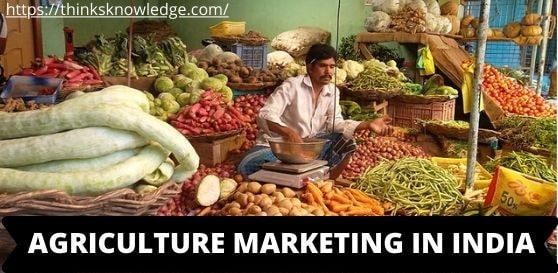India is an agricultural country, and agriculture plays an essential role in the Indian economy. The purpose of agriculture in our country is to enhance national income, employment, capital formation, foreign trade, and industries. Agriculture marketing in India includes storage, processing, and marketing of forestry, gardening, and other agricultural products. Distribution of farm machinery and the movement of farm products at the regional level.

About 70 percent of the Indian population is dependent on agriculture, and near about 64 percent of the workers employed in the agriculture sector. Agricultural marketing activities like transportation, processing, storage, grading, etc. is become a help to the farmers. These activities play a vital role in the economy of all countries.
Table of Content
GOVERNMENT SCHEMES
There are several schemes to promote agricultural marketing both in for states & the Government of India. The targets of these schemes are aimed to promote various agricultural marketing activities. Agricultural marketing is focused on infrastructure and promoting an integrated supply chain for ethical marketing practices to attract private investment.
- Integrated Scheme for Agricultural Marketing (Central plan): This plan for Construction of agricultural marketing infrastructure.
- Mission on Integrated Horticulture Development: Vegetable initiative for urban groups to establish a good cycle of production and income for farmers and assured supply for consumers.
- Agricultural and Processed Food Products Export Development Authority (APE DA): this is for the Infrastructural development plan.
- Pledge Loan Plan: In instead of pledging to give their agricultural produce, farmers can be paid a loan equal to an amount of Rs. 2, 00,000 or 60 percent of the farm yield. The period of an advance granted shall not exceed 180 days from the date of the pledge of production.
- Raitha Sanjeevani: Agriculture Insurance Scheme for the benefit of all farmers of Karnataka. If a farmer or a member of his family in the age group of 15 to 60 dies while doing agricultural work, compensation of 75,000 has been approved.
- Minimum Base Price Scheme: To help farmers with distress sales, a floor price plan has been formulated. The Government will declare the minimum support price and procurement will be arranged at that price.
- The Farmers Market (Peacock Market): Construction/extension work of rural godowns by individuals, farmers, farmer-producers, partnership / proprietary companies, NGOs, self-help groups, companies, groups of cooperatives, agricultural marketing societies, marketing boards, and agricultural production processing corporations of the country.
PROBLEM IN AGRICULTURAL MARKETING
1. Too Many Intermediates
One of the main drawbacks of Indian agricultural marketing in India is the presence of too many middlemen. Those middle people are the exploitation of farmers. These mediocre people make use of the farmers by purchasing the produce at low prices, and they exploit the customer’s sales on higher rates from them.
2. Lack of Financial Resources
There is a lack of financial resources in rural areas, due to which their emergency requirements are also not available. In these situations, farmers sell their crops before maturation. Loans installments for pumping sets, tractors, threshers are paid on a monthly or quarterly basis. This is the main cause of selling their crops before maturity.
3. Illiteracy & Lack of Unity
Maximum Indian farmers are illiterate and unaware of the market price. Due to their simple nature, they are easily conveyed by moneylenders, traders, and middlemen. Similarly, the lack of unity among farmers also a reason for the exploitation of Indian farmers. This exploitation is spread over and wide in rural areas.
4. Defective Weights & Scales
The biggest drawback of agriculture marketing in India is inadequate weight and scales. Generally, weights and scale used in rural areas that is poor weights measurement are found markets. Thus, the grain of the farmer is weighed with a heavyweight for his own benefit. Most traders carry different weights for the purchase and sale of grain.
5. Lack of Transport Facilities
On the rainy season, roads from villages to cities are usually not capable of transport. Bullock carts can carry products (crops) only to a limited area. During the lack of transport facilities, the farmer is unable to take his crops to the fair market. That is the main cause for they are unable to get a fair price of crops.
6. Lack of Organized Marketing System
Agriculture marketing in India does not properly work only because of unorganized marketing. Government organization works on this marketing system to become an organized market. The Government works on cooperatives, government marketing, and regular markets.
UPGRADE SYSTEM OF AGRICULTURAL MARKETING
After independence, the Government has adopted many measures to improve the system of agriculture marketing in India, that is:
1. Organization of the regular market
Regular markets are established only to protect the farmer’s exploitation from vendors and intermediaries. These markets are managed by a market committee, and this candidate appointed by the state government, local bodies, mediators, and farmers. Thus, the committee are representative on the interests of all.
2. Use of Standard Weights
Under this, the products are weights through the right measurement weights. Farmers got the right price for their products. The Government’s focus on this measurement allows a standard weight for better agriculture marketing in India.
3. Grading and Standardization
Agriculture marketing in India has to improve classification and standardization. Agricultural Products (Grading and Marketing) Act was passed in 1937. In the beginning, grading was introduced for cannabis and tobacco.
4. Dissemination of Market Information
The recent market price is available to the farmers. This information system makes it an important rate/price of crops in the market.
5. Warehousing and Storage Facilities
The Government provides facilities to the farmers. They have to collect the value of their products. This kind of warehousing and storage facility helps to grow the farmer’s capacity. So that, the value addition of the crops can be make good advantage.
6. Government Prepares Procurement & Pricing
Every year the Government declares the minimum support price of food grains. In this, the farmers can be encouraged to produce more and more crops of high production. Farmers are receiving the right amount of food grains.
AGRICULTURAL MARKETING COOPERATIVE SOCIETY
The members of cooperative societies are farmers who sell their surplus production to this institution. The farmers give their crops to the societies then the societies provide financial arrangements to the farmers. The farmers can carry out their activities very smoothly. Such types of committees also collect the agricultural product from its members. These committees are aware of both the market and the selling price. The most favorable point of agriculture marketing in India.
- Some of the essential advantages of cooperative marketing institutions are:
- Marketing committees collect bargains.
- The farmer has a little bargaining capacity for its prices of crops.
- The committees get reasonable rates from the market through this system.
- Marketing committees provide finance to farmers.
- Farmers can keep their produce with them for receiving a comparable price from the market.
- These committees provide the storage system to the farmers.
- Arranges crop insurance so that the loss of farmers can be reduced.
- These committees motivate farmers to produce better.
- These committees end brokers and try to provide the maximum price to the farmers.
Therefore, that is some loopholes in agricultural marketing in India. In current time agricultural produce independently from the land. Market control by any other person is an essential factor we can understand. Improvement in the traffic system becomes a benefit for farmers in a capitalistic manner. The farmer grows succeeded in getting a fair price for their “Marketing Surplus” but all of them benefit in the middle category.





